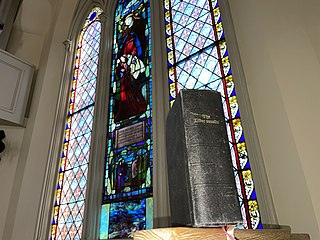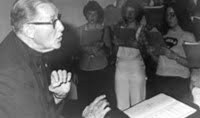
The Roman Missal is the title of several missals used in the celebration of the Roman Rite. Along with other liturgical books of the Roman Rite, the Roman Missal contains the texts and rubrics for the celebration of the most common liturgy and Mass of the Catholic Church.

Sacrosanctum Concilium, the Constitution on the Sacred Liturgy, is one of the constitutions of the Second Vatican Council. It was approved by the assembled bishops by a vote of 2,147 to 4 and promulgated by Pope Paul VI on 4 December 1963. The main aim was to revise the traditional liturgical texts and rituals to reflect more fully fundamental principles, and be more pastorally effective in the changed conditions of the times, clarifying not only the role of ordained ministers but the modalities of appropriate participation of lay faithful in the Catholic Church's liturgy, especially that of the Roman Rite. The title is taken from the opening lines of the document and means "This Sacred Council".
Semiology is a branch of Gregorian Chant research. Semiology refers specifically to the study of the neumes as found in the earliest fully notated manuscripts of Gregorian Chant, the oldest of which have been dated to the 9th century. The first application of the term 'semiology' for the study of Latin chant was made by Dom Eugène Cardine (1905–1988), a monk of the Abbey of Solesmes. In this context, 'semiology' is understood as 'the study of musical signs'. Text and neumatic notation, together with significative letters adjoined to the neumes, presents an effective and integrated mnemonic for the rhythmical interpretation and the melody. While Gregorian palaeography offers a description of the various neumes and their rhythmical and melodic values, Gregorian semiology explains their meaning for practical interpretation.

The Mass of Paul VI, also known as the Ordinary Form or Novus Ordo, is the most commonly used liturgy in the Catholic Church. It is a form of the Latin Church's Roman Rite, and was promulgated by Pope Paul VI in 1969 and published by him in 1970; it was then revised in the 1975 edition of the Roman Missal, further revised by Pope John Paul II in 2000, and published in a third edition in 2002.

Gregorian chant is the central tradition of Western plainchant, a form of monophonic, unaccompanied sacred song in Latin of the Roman Catholic Church. Gregorian chant developed mainly in western and central Europe during the 9th and 10th centuries, with later additions and redactions. Although popular legend credits Pope Gregory I with inventing Gregorian chant, scholars believe that it arose from a later Carolingian synthesis of the Old Roman chant and Gallican chant.

The gradual is a chant or hymn in the Mass, the liturgical celebration of the Eucharist in the Catholic Church, and among some other Christians. It gets its name from the Latin gradus because it was once chanted on the step of the ambo or altar. In the Tridentine Mass, it is sung after the reading or chanting of the epistle and before the Alleluia, or, during penitential seasons, before the tract. In the Mass of Paul VI, the gradual is usually replaced with the responsorial psalm. Although the Gradual remains an option in the Mass of Paul VI, its use is extremely rare outside monasteries. The gradual is part of the proper of the Mass.

A missal is a liturgical book containing instructions and texts necessary for the celebration of Mass throughout the liturgical year. Versions differ across liturgical tradition, period, and purpose, with some missals intended to enable a priest to celebrate Mass publicly and others for private and lay use. The texts of the most common Eucharistic liturgy in the world, the Catholic Church's Mass of Paul VI of the Roman Rite, are contained in the 1970 edition of the Roman Missal. Missals have also been published for earlier forms of the Roman Rite and other Latin liturgical rites. Other liturgical books typically contain the Eucharistic liturgies of other ritual traditions, but missals exist for the Byzantine Rites, Eastern Orthodox Western Rites, and Anglican liturgies.
Guillaume-Gabriel Nivers was a French organist, composer and theorist. His first livre d'orgue is the earliest surviving published collection with traditional French organ school forms. Nivers's other music is less known; however, his treatises on Gregorian chant and basso continuo are still considered important sources on 17th century liturgical music and performance practice.
The Litany of the Saints is a formal prayer of the Roman Catholic Church as well as the Old Catholic Church, Anglo-Catholic communities, and Western Rite Orthodox communities. It is a prayer to the Triune God, which also includes invocations for the intercession of the Blessed Virgin Mary, the Angels and all the martyrs and saints upon whom Christianity was founded, and those recognised as saints through the subsequent history of the church. Following the invocation of the saints, the Litany concludes with a series of supplications to God to hear the prayers of the worshippers. It is most prominently sung during the Easter Vigil, All Saints' Day, and in the liturgy for conferring Holy Orders, the Consecration of a Virgin and reception of the perpetual vows of a religious or a diocesane hermit.

The Liturgy of the Hours or Divine Office or Opus Dei are a set of Catholic prayers comprising the canonical hours, often also referred to as the breviary, of the Latin Church. The Liturgy of the Hours forms the official set of prayers "marking the hours of each day and sanctifying the day with prayer." The term "Liturgy of the Hours" has been retroactively applied to the practices of saying the canonical hours in both the Christian East and West–particularly within the Latin liturgical rites–prior to the Second Vatican Council, and is the official term for the canonical hours promulgated for usage by the Latin Church in 1971. Before 1971, the official form for the Latin Church was the Breviarium Romanum, first published in 1568 with major editions through 1962.

The Liber Usualis is a book of commonly used Gregorian chants in the Catholic tradition, compiled by the monks of the Abbey of Solesmes in France. According to Willi Apel, the chants in the Liber Usualis originated in the 11th century.
The Little Office of the Blessed Virgin Mary, also known as Hours of the Virgin, is a liturgical devotion to the Blessed Virgin Mary, in imitation of, and usually in addition to, the Divine Office in the Catholic Church. It is a cycle of psalms, hymns, scripture and other readings.
The International Commission on English in the Liturgy (ICEL) is a commission set up by a number of episcopal conferences of English-speaking countries for the purpose of providing English translations of the liturgical books of the Roman Rite, the originals of which are in Latin.

Liturgical music originated as a part of religious ceremony, and includes a number of traditions, both ancient and modern. Liturgical music is well known as a part of Catholic Mass, the Anglican Holy Communion service and Evensong, the Lutheran Divine Service, the Orthodox liturgy and other Christian services including the Divine Office. Some claim that such ceremonial music in the Christian tradition can be traced back to both the Jewish Temple in Jerusalem and synagogue worship of the Jews.

An antiphonary or antiphonal is one of the liturgical books intended for use in choro, and originally characterized, as its name implies, by the assignment to it principally of the antiphons used in various parts of the Latin liturgical rites.

The Kyriale is a collection of Gregorian chant settings for the Ordinary of the Mass. It contains eighteen Masses, six Credos, and several ad libitum chants. This collection is included in liturgical books such as the Graduale Romanum and Liber Usualis, and it is also published as a separate book by the monks of Solesmes Abbey.
Contemporary Catholic liturgical music encompasses a comprehensive variety of styles of music for Catholic liturgy that grew both before and after the reforms of the Second Vatican Council. The dominant style in English-speaking Canada and the United States began as Gregorian chant and folk hymns, superseded after the 1970s by a folk-based musical genre, generally acoustic and often slow in tempo, but that has evolved into a broad contemporary range of styles reflective of certain aspects of age, culture, and language. There is a marked difference between this style and those that were both common and valued in Catholic churches before Vatican II.

In Christianity, concelebration is the presiding of a number of presbyters at the celebration of the Eucharist with either a presbyter or bishop as the principal celebrant and the other presbyters and bishops present in the chancel assisting in the consecration of the Eucharist. The concelebrants assist the principal celebrant by reciting the Words of Consecration together with him, thus effecting the change of the eucharistic elements. They may also recite portions of the Eucharistic Prayer. Concelebration is often practiced by ministers of Churches that are in full communion with one another, e.g. the Anglican Communion and the Old Catholic Church.

The Roman Gradual is an official liturgical book of the Roman Rite of the Roman Catholic Church containing chants, including the proper and many more, for use in Mass.

Cletus Madsen was a 20th-century Catholic priest of the Diocese of Davenport in the US state of Iowa. He was involved the Liturgical Movement in the Catholic Church in the mid-20th century.














